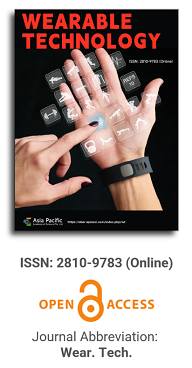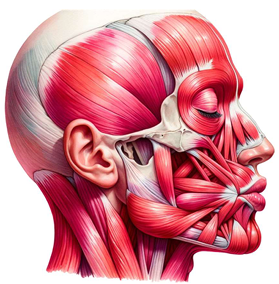

This paper delves deeply into the innovative realm of integrating human emotions with wearable technology. The primary focus is on the conceptualization and development of a kiss transfer device that harnesses the power of wearable technology to bridge the physical gap in human-human interactions. By investigating the intricate nuances of the human-human kissing process, the research seeks to replicate this intimate gesture through a technological medium. The paper not only elaborates on the anatomy, evolution, and hormonal dynamics of kissing but also underscores the transformative potential of wearable technology in capturing and transmitting these intimate moments. This exploration opens up new horizons for long-distance relationships, offering a tangible touchpoint that goes beyond traditional communication methods. Through this pioneering work, the research positions wearable technology as not just a tool for communication but as an extension of our human emotions and expressions.

A method of attitude measurement and level assessment for skiers based on wearable inertial measurement
Vol 3, Issue 1, 2022
Download PDF
Abstract
Quantitative analysis of sports is an important development direction of scientific skiing training, and the digital expression of human movement patterns during skiing is the basis for scientific quantitative analysis. A human motion capture and attitude reconstruction system based on a wearable BSBD inertial measurement unit was designed and built, combined with the human multi-rigid body motion model to realize the human body reconstruction during the skiing, and applied to the auxiliary training of slewing movements in alpine skiing. At the same time, for the indoor training scene based on the multi-degree-of-freedom simulated ski training platform, a digital evaluation method suitable for ski slalom is proposed. The method uses motion capture system and posture reconstruction system to extract five kinds of sliding characteristic data of skiers, and realizes the evaluation of skiers’ technical parameters through similarity measurement and linear fitting with high-level athletes’ motion parameters, so as to assist scientific training. Finally, experiments are carried out on the indoor Olymp simulated ski training bench to verify the effectiveness of the method.
Keywords
References
- Jegham I, Khalifa AB, Alouani I, et al. Vision-based human action recognition: an overview and real world challenges. Digital Investment 2020; 32: 200901.
- Roetenberg D, Luinge H, Slycke P. Xsens MVN: full 6DOF human motion tracking sensors. Xsens Motion Technologies Bv 2009.
- Zhang X, Shi Y, Zhang Y. A CAN-based Internal Sensor Network for Lower Limb Exoskeleton. Proceedings of IEEE International Conference on
- Communication Problem-Solving (ICP); 2015 Mar 19; Beijing. 473–476.
- Li J. Research on real-time capture system of Human post based on motion sensing [Master’s thesis]. Nanchang: East China JiaoTong University, 2016.
- Zhang Z, Wu J. A novel hierarchical information fusion method for three-dimensional upper limit motion Estimation. IEEE Transactions on Instrumentation & Measurement 2011; 60(11): 3709–3719.
- Zhang Z, Wong W, Wu J. Ubiquitous human upper-limb motion estimation using wearable sensors. IEEE Transactions on Information Technology in Biomedicine 2011, 15(4): 513–521.
- Tao G, Sun S, Huang S, et al. Human modeling and real-time motion reconstruction for micro-sensor motion capture. Proceedings of IEEE International Conference on Virtual Environments Human-Computer Interfaces & Measurement Systems; 2011 Jan 1.
- Li G, Wu Z, Meng X, et al. Modeling of human body for animation by micro-sensor motion capture. Proceedings of 2009 2nd International Symposium on Knowledge Acquisition and Modeling (KAM); 2009; 98–101.
- Ghasemzadeh H, Loseu V, Guenterberg E, et al. Sport training using body sensor networks: A static approach to measure wrist rotation for golf swing. Proceedings of 4th International Conference on Body Area Networks. Los Angeles: ICST; 2009. p. 2–9.
- Sharma M, Srivastava R, Anand A, et al. Wearable motion sensor based phasic analysis of tennis server for performance feedback. Proceedings of 42th International Conference on Acoustics, Speech and Signal Processing; 2017 New Orleans: 2017. 5945–5949.
- Samir R, Derek P, Timothy U. Wearable IMU for shoulder injury prevention in overhead sports. Sensors 2016; 16(11): 1847.
- Chan J, Leung H, Tang J, et al. A virtual reality dance training system using motion capture technology. IEEE Transactions on Learning Technologies 2011; 4(2): 187–195.
- Pang M. Kinematics analysis of V2 coasting technique of young elite cross-county skiers in China. Shijiazhuang: Hebei Normal University, 2020.
- Chen X. Study on core strength training of giant slalom athletes in alpine skiing. Science Public (Science Education) 2012; 11: 168–169.
- Ren L. Research on teaching and training methods of alpine skiing slewing technique. Naked (upper middle) 2015; 8: 334–335.
Supporting Agencies
Copyright (c) 2022 Yijia Zhang, Xiaolan Yao, Yongqiang Han, Peizhang Li, Hao Zhang, Hongqing Cao, Xuyang Fang

This work is licensed under a Creative Commons Attribution 4.0 International License.

Prof. Zhen Cao
College of Information Science & Electronic Engineering, Zhejiang University
China, China
Processing Speed
-
-
-
- <5 days from submission to initial review decision;
- 62% acceptance rate
-
-
Asia Pacific Academy of Science Pte. Ltd. (APACSCI) specializes in international journal publishing. APACSCI adopts the open access publishing model and provides an important communication bridge for academic groups whose interest fields include engineering, technology, medicine, computer, mathematics, agriculture and forestry, and environment.





